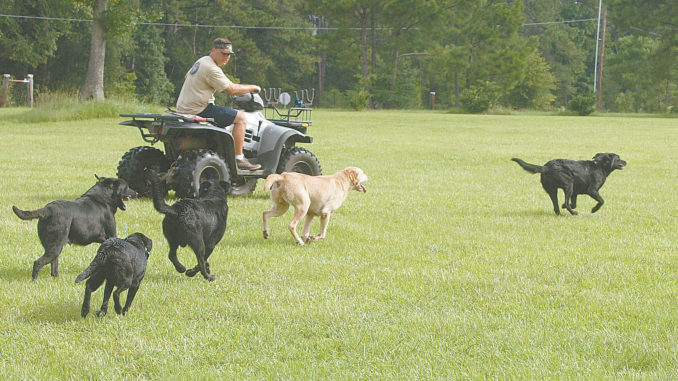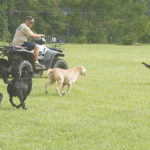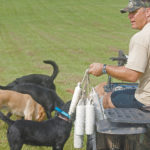
Start duck-hunting prep now, dog trainer says.
As we find ourselves a month away from kicking off the 2011-12 waterfowl seasons, it’s a great time to gather up your gear to get ready for the November openers. For many, the list of essential items includes a four-legged buddy in addition to the usual guns, ammo, decoys and clothing.
Just like a duck boat left idle since January, retrieving dogs aren’t typically in tip-top shape after a lazy summer, unless you’re one of the few that works your dog in the off-season.
Daniel Goldsby of Goldsby Retriever & Obedience in Amite offered some insight to sharpen up your retriever in time for opening day.
According to Goldsby, technical work like refreshing the dog on hand signals and blind retrieves is important, but he stressed that a dog must get back into shape first and foremost.
“Getting a dog into aerobic shape is important prior to getting into a heavy training regimen,” Goldsby advised. “I’ll often take my dogs out for jogs around my fields or a pond, letting them follow me on my ATV.”
Goldsby noted for handlers to begin this aspect of training slowly so as not to overexert a dog that’s been out of the game for a while.
“I’ll usually take a few laps around my pond and then let the dogs cool off with a swim,” he said.
If temperatures are still indicative of early September instead of October, Goldsby advises to watch your dog carefully for signs of heat stress.
“Dogs will pant instead of sweating, but keep an eye out for extreme panting, particularly if a dog becomes lethargic or disoriented as that can lead to heat stroke,” he warned.
If a dog does exhibit these symptoms, it’s critical to provide only cool water to aid in cooling the dog instead of ice cold water, which can lead to shock. Nevertheless, Goldsby advised to always keep water available for the dog during training exercises whether it’s in a river or pond, or brought from home in a bottle.
Once a dog seems to be keeping up with aerobic exercise, Goldsby suggests started off going back to basics.
“I’ll usually start off with reinforcing commands like ‘sit,’ ‘stay’ and ‘come’ along with basic obedience. If a dog has been trained on an electronic collar, I’ll continue training with the collar,” he said.
According to Goldsby, this is also a great time to take the dog out to the blind in order to practice these same commands in the specific hunting scenario the dog will work in during the season, whether it’s a rice field pit, boat blind or timber stand.
Once the dog appears to have sharpened up on the basic commands, Goldsby will get the retrieving going in earnest.
“Dummy launchers with .22-caliber blanks are an excellent tool to both mimic the shot and get the dog to mark a fallen bird,” he said. “I’ll start out with single marks, but will eventually work up to multiple marks to work the dog’s memory.”
When possible, Goldsby suggests using real birds to help reintroduce the feel of a live bird to a dog, which will avoid hard-mouthing.
“If the real thing isn’t available to you, scented bumpers can also be great to help get the dog accustomed to the scent of the real bird,” he added.
As a dog begins to gain confidence in making marks, Goldsby stressed the importance of similarly working on blind retrieves, which brings one final but critical element into play: the dog’s nose.
“Throwing bumpers into heavy cover is very important in getting the dog to ‘hunt’ the bird with his nose,” he said.
This portion of the tune-up also plays into handling the dog using a whistle and hand signals.
“I’ll work on a ‘T Drill’ using hand signals to make sure we’re on the same page when it comes time for a longer distance blind retrieve,” Goldsby added.
It’s at this time he works heavily on commands like “Right Overs,” “Left-Overs” and “Back” to help guide a dog to a fallen bird. Mastering these commands comes in awfully handy when that chipped speck sails off into the next field over or that crippled teal scurries into the dense marsh grass at pond’s edge.
One other item Goldsby stressed was to work your dog in, around and beyond a decoy spread when preparing for the season.
“Many times a dog needs to be reacquainted with seeking out a fallen bird within the decoys,” he said.
Goldsby noted that it’s also important to work your dog beyond the decoy spread as sometimes they can become hesitant to seek out fallen birds at longer distances.
With just over a month to go, now is a great time to reinvigorate the bond between retriever and handler, as time invested in October can prevent a lot of frustration for both when mid-November rolls around.
With Goldsby’s tips, your dog should be raring to go when the first few birds of the season hit the pond.
Check out what other users are saying about duck season in the LouisianaSportsman.com Waterfowl Hunting Forum, and be sure to post your own reports.
Not already a registered user? Just fill out the short registration form to get started today!
Editor’s Note: Daniel Goldsby can be reached at 985.517.0773 or on his Web site.
Cutline: According to retriever trainer Daniel Goldsby, scented bumpers help dogs get accustomed to the scent of real birds.




